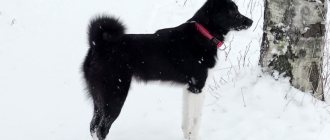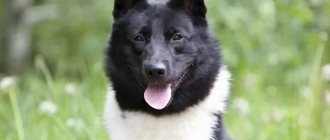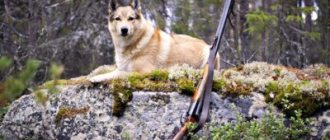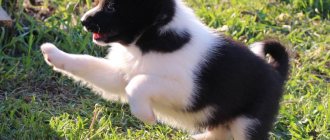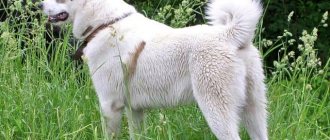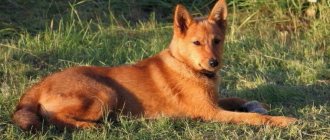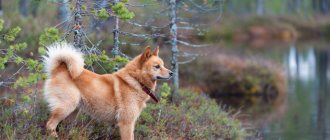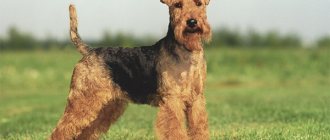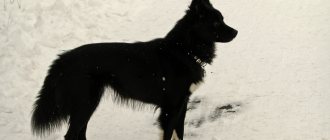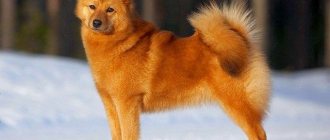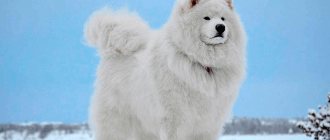The Russian-European Laika belongs to the category of domestic breeds of medium-sized hunting dogs. The special qualities of this dog are increased endurance and an enthusiastic attitude to work. The husky has a complex character, but a competent approach to education will make this dog a reliable companion who will guard your home or go hunting with you.
Breed standard and description
Height at withers: males 52-58 cm, females 48-54 cm; Weight: 18-23 kg (proportional to height).
- Typical colors: black and white, white and black, solid white or black.
- Eye color: dark brown or brown.
- Nose color: black.
- General appearance: A medium sized, square dog with erect ears, a wedge-shaped muzzle and a curled tail.
History of the Russian-European Laika breed
Travelers have described hunting dogs with pointed ears and curled tails since the days of Tsarist Russia. The Russian-European Laika is a composite image that was formed into a single whole thanks to the work of Soviet dog handlers.
Initially, the habitat area extended to the following modern regions and republics:
- Arkhangelskaya;
- Moscow;
- Vladimirskaya;
- Yaroslavskaya;
- Tverskaya;
- Vologda;
- Komi;
- Udmurtia.
There these huskies lived in settlements. They were taken hunting and left to guard the house and household . Unpretentious animals survived after an encounter with a wild animal, helping the owner in the hunting craft. Previously, they were called Zyryansky and Cheremissky Laikas because of the terrain.
In the 40s of the last century, breeders took up the Russian-European Laika. They selected outstanding individuals for further breeding and use in fishing. Leningrad became one of the centers of breeding work. The first breed standard was published in 1952.
It is interesting that the common color of modern huskies is a heritage from a couple of manufacturers, and not from nature.
At that time, West Siberian huskies took part in matings. Therefore, in both breeds the blood of representatives of both ZSL and REL flows, which only improves working qualities and reinforces correct behavior with anatomy. The ancestor of the modern population is considered to be a dog named Putik .
The breed is recognized by the FCI, but most of the livestock is registered in various hunting cynological organizations. For example, RORS and RFOS, which was previously a member of the RKF. The latest version of the ICF standard was released in 2011.
West Siberian
This breed is the most numerous, in terms of the number of heads, and the most common among hunters. It is distinguished by its predatory appearance; it is more like a wolf in color and temperament than others. Not large in size - 52-60 cm at the withers, with a weight of 16-22 kg . Externally a strong animal, elongated format. It is considered a universal hunting dog.
Country of origin: USSR (Russia). The breed received recognition in 1980 and is officially registered by the International Canine Organization.
In proportions and appearance it is not much different from the East Siberian. A special feature can be considered deep-set, sharply slanted eyes and a predatory gaze. Preferred colors : white, piebald, brown, gray, red.
The breed does not cause any difficulties in caring for. West Siberian huskies are unpretentious. They can go for a long time without water and food, work hard, and hunt. Such dogs need space; living in an apartment will negatively affect their well-being. In order for a pet to live on the street, it needs to be equipped with an enclosure or a booth with a soft chain. It is important to regularly go hunting with your animal or just for walks in the forest.
Read a detailed article about the breed: “The West Siberian Laika is an excellent hunter and a cheerful companion.”
A puppy without a pedigree can be purchased for 3,000-5,000 rubles , a pet-class or breed-class for 15,000-20,000 rubles , a show class dog for 25,000 rubles .
Temperament and character
Russian-European Laikas have the following positive traits:
- Equilibrium;
- Developed intelligence;
- Working qualities at a high level;
- Activity;
- Endurance;
- Devotion.
Negative:
- Willfulness;
- Tendency to escape;
- They love to voice.
Some traits (vocality) are valued by hunters, but can be problematic for urban keeping.
Man and dog
The Russian-European Laika is a working dog, so it is adopted by hunters and active people . Such a pet needs to splash out energy and show skills. The character of the Russian-European Laika is not suitable for elderly people, children and lovers of a relaxing holiday.
REL are distrustful of strangers, they have a viciousness that helps in pursuing the beast. However, there is no aggression towards humans , but they show true love and loyalty only to the owner and family members. REL are able to identify a stranger with their voice and protect the farm from lost forest animals. They bark loudly at suspicious people, but they cannot detain them.
The best place for a Russian-European Laika to live is a private house with a large area or a spacious enclosure. Adults are often placed on a long chain near the booth, with the condition of regular walks and prolonged communication with the owner. There are also apartment dogs of this breed with a stable psyche, if they are provided with sufficient stress.
Russian-European huskies are insensitive to pain, so they tolerate playing with children without showing aggression. The main thing is that the dog is well-mannered, and the child knows how to handle animals correctly.
is accustomed to pets , including birds, from puppyhood. Then there will be no creeping towards other animals when the hunter’s instincts manifest themselves. They get along well with the dogs in their home, getting used to living in a pack.
Reviews
A few reviews:
- “You can only have a husky in an apartment if you have a rented home and you hate your tenants. Or if you are looking for a reason to renovate. Our Patrick broke everything, and what he didn’t break, he broke. He tore off the wallpaper and scratched the door. And all because he was bored. He also intimidated the cat so much that he lived only on the balcony and refused to enter the room. I had to carry it in by force.”
- “I have been interested in hunting and breeding dogs for a long time. This is the best breed for me."
Maintenance and care
REL are hardy dogs with a thick undercoat and a coarse coat that protects the animal from the elements. Because of these features, huskies tolerate heat and frost well . They are not worn even at very low temperatures.
The Russian-European Laika requires daily walks . Free movement ensures the health and psychological comfort of the pet. On weekends, it is advisable to go out with the dog into the forest and fields and let him run around as much as he can.
Feeding
An approximate diet consists of the following products:
- Raw meat and offal (beef, horse meat, chicken) – 80%.
- Fermented milk products (cottage cheese, whey, kefir) – 15%.
- Sea or ocean fish – once a week.
- Raw or boiled egg – 1-2 times a week.
- Rice and buckwheat porridge - in the cold season.
The last point allows the dog to maintain the desired condition with high energy expenditure. Dry food is suitable for active medium-sized dogs. Laikas must be dry and strong, without a hint of excess fat, in order to move normally. The outer ribs of a healthy and mature dog can be felt without effort.
REL makes quick work of the bones and considers them a treat. Do not give chicken and any boiled bones, which clog the stomach and cause wounds of the esophagus, indigestion. Usually REL is not fed with chondroprotectors or complex vitamins if the basic diet is balanced and health is in order.
Grooming
Grooming is simple. Like all dogs with abundant undercoat, the Russian-European Laika sheds seasonally . At this point, combing is necessary 2-3 times a week using a slicker brush. In other cases, it is enough to go through the fur once a week with a long-toothed brush. Dirt quickly comes off of their fur after drying.
To speed up shedding, the dog can be washed with shampoo and dried thoroughly. This will make mature hair come off easier, and there will be less hair in the house.
Select deep cleaning products or universal shampoo from a pet store. Grooming of Russian-European Laikas is not provided for .
Puppies' ears stand up at 2-3 months. Sometimes the process is delayed, but by 6 months their final position will become clear. They are cleaned for preventive purposes with a cotton pad soaked in a special lotion or peroxide. If dark plaque or non-healing abrasions occur, you should contact your veterinarian. Claws are trimmed if they are overgrown and interfere with the animal’s movements.
How to choose?
In order to choose the right healthy black Samoyed puppy for your family, you need to be careful and pay attention to all deviations in behavior and structure, even the smallest ones.
On the other hand, if you need a dog not for exhibitions and competitions, you may well neglect some of the aspects of the standard, especially since a dog with flaws will cost less than an ideal representative of the breed.
Here are the factors that a potential buyer needs to pay attention to when choosing a Samoyed puppy:
- Pay attention to the conditions in which the litter is found. The room must be clean, without any unpleasant odor. Also look at what the mother looks like. She should not be emaciated, tortured or dirty.
- If you need a purebred representative, then ask for all the documents that would contain information about the puppy’s pedigree.
- You also need to inquire about hereditary diseases, and what is the likelihood that they will manifest themselves in this particular offspring.
- The puppy must be active and mobile. Healthy individuals are characterized by curiosity and a desire to quickly get to know a stranger.
- Do not choose aggressive and cowardly puppies who hide or snap at your sight.
- According to the standard, the puppy should have a small head, almond-shaped eyes, and a wide muzzle. The ears should be triangular and set wide apart. The coat should be clean, without bald patches and dandruff, and the undercoat should be dense.
- Ask for all documents proving vaccinations received, as well as a passport.
- The puppy should have a healthy appetite and normal bowel movements without the presence of parasites.
Education and training
These dogs are trained in household commands and work with animals from the first months of life. Due to the fact that the REL is designed for hunting, its decisions sometimes come as a surprise to the novice owner. However, an experienced dog handler distinguishes between the pet’s reactions. For everyday life, learn standard commands:
- "To me";
- "Place";
- "It is forbidden";
- "Sit".
An important rule is not to hit the dog , but to find an approach to it, otherwise contact will be lost. REL remember commands after dozens of repetitions and periodic reinforcement. Strictness must be present in the education of the Russian-European Laika. The best training is hunting.
Hunting reveals the natural potential in a particular animal, but humans help in this.
To learn the trade, you can go to baiting stations where there are animals suitable for huskies: badger, bear, wild boar. REL track and chase them both alone and in pairs with other dogs.
Training occurs gradually. There are times when an adult and experienced dog shows a junior how to work correctly. The owner can consolidate the acquired skills and also show at the baiting station what not to do.
Trials, tests and competitions are practiced all over the world to test the abilities of hunting dogs. In one breed there are both gifted individuals and those unsuitable for working with animals, despite heredity and upbringing. The FCI rules require passing working tests to introduce a dog into breeding.
General conclusion about the Norwegian Black Elkhound
The Norwegian Black Husky is suitable for hunters living in rural areas, as it can be kept well in an enclosure. It is strictly forbidden to keep him on a chain: the dog’s psyche may deteriorate. Outside the city, it is possible to walk your pet for a long time, which is beneficial for its physical health. Easy to train and remembers commands well. It may well become an indispensable assistant.
Previous entry Hunting marten: methods, secrets, techniques
Next entry Instead of a son
Health and life expectancy
Russian-European huskies live on average 12-14 years . Common diseases:
- Urolithiasis disease.
- Loss of voice.
- Epilepsy.
The breed is practically free from severe hereditary diseases. Injuries and infections acquired during hunting pose a great danger. Therefore, Russian-European huskies are vaccinated strictly on time and treated against ticks, fleas and mosquitoes. Many of the diseases manifest themselves due to improper nutrition and maintenance, for example, obesity, bronchitis, allergies and joint dysplasia.
Price range
Now the Samoyed Laika breed is very popular, not only in our country, but throughout the world.
NOTE!
The average price at which you can purchase a representative of this breed ranges from 15 to 45 thousand rubles.
There are also many pricing factors. First of all, these include the status of the nursery and the conditions for keeping the puppies, the age of the pet you are planning to take into the family, the pedigree, the status of the dog and its exclusivity.
For example, pet class puppies will cost much less than show class puppies.
Since breeders fight for the rights of black Samoyeds in exhibitions, such a division into classes and pedigree is natural. People are trying to make the hierarchy of dogs as close as possible to purebred individuals.
Breed photo
A selection of photos of Russian-European huskies.
